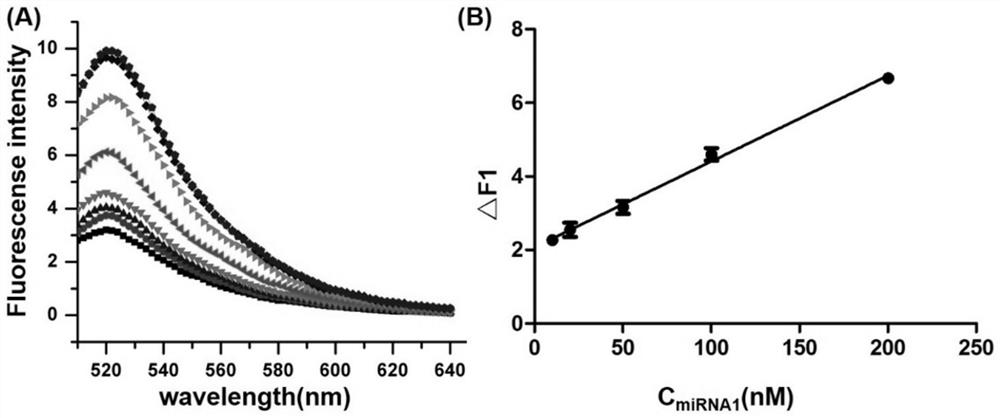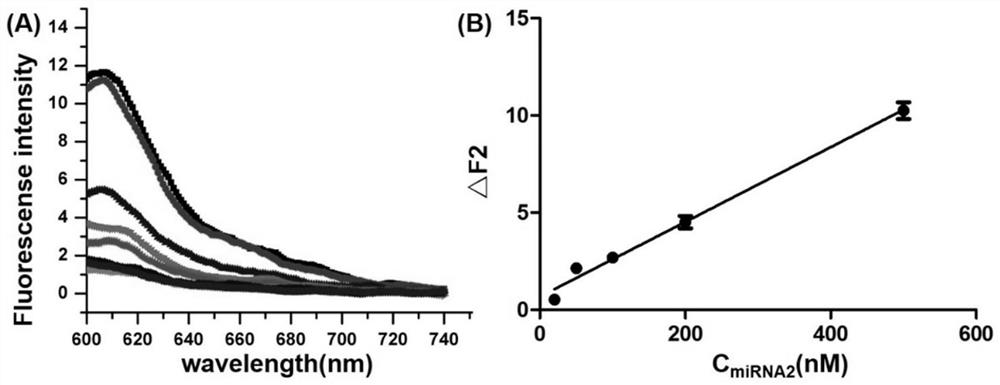Fluorescence detection system, fluorescence biosensor and application thereof
A fluorescence detection and system technology, applied in fluorescence/phosphorescence, instruments, measuring devices, etc., can solve the problems of cumbersome detection steps, limited quantitative accuracy, and high detection cost, and achieve easy surface modification, low cost, and high signal-to-noise ratio Effect
- Summary
- Abstract
- Description
- Claims
- Application Information
AI Technical Summary
Problems solved by technology
Method used
Image
Examples
Embodiment 1
[0042] This embodiment provides a fluorescence detection system, including the following components:
[0043] 1. The first fluorescent probe, the first fluorescent probe is a single-stranded DNA probe pDNA1 labeled with the fluorescent molecule 6-FAM at the 5' end, the nucleotide sequence of pDNA1 is shown in SEQ ID NO.1, the first fluorescent probe The needles recognize and bind miRNA1, a biomarker molecule for Alzheimer's disease.
[0044] 2. The second fluorescent probe, the second fluorescent probe is a single-stranded DNA probe pDNA2 labeled with a fluorescent molecule ROX at the 5' end, the nucleotide sequence of pDNA2 is shown in SEQ ID NO.3, the second fluorescent probe can Recognizes and binds miRNA2, a biomarker molecule for Alzheimer's disease.
[0045] 3. The third fluorescent probe, the third fluorescent probe is a single-stranded DNA probe pDNA3 labeled with a fluorescent molecule Cy5 at the 5' end, the nucleotide sequence of pDNA3 is shown in SEQ ID NO.3, the t...
Embodiment 2
[0050] This embodiment provides a fluorescent biosensor, including the fluorescence detection system in Embodiment 2. Fluorescent biosensors can realize the rapid detection of biomarker molecules of Alzheimer's disease, and have the advantages of fast, simple, sensitive, efficient and accurate, and can be used for disease screening of Alzheimer's disease with diagnosis.
experiment example 1
[0052] 1. Purpose of the experiment: To detect the specificity and sensitivity of the first fluorescent probe, the second fluorescent probe and the third fluorescent probe in Example 1 binding to the target biomarker molecule.
[0053] 2. Experimental process and results:
[0054] The fluorescence spectra of the three fluorescent probes were detected before incubation with graphene oxide, after incubation with graphene oxide, and after incubation with graphene oxide and miRNA, and the first fluorescent probe was recorded at 510nm-640nm band (excitation wavelength: 490nm), the fluorescence emission spectra of the first fluorescent probe in the 600nm-740nm band (excitation wavelength: 580nm) and the third fluorescent probe in the 670nm-790nm band (excitation wavelength: 640nm), the results are as follows figure 1 shown.
[0055] figure 1 A shows the change of the fluorescence emission spectrum of the first fluorescent probe pDNA1 under three conditions: in the absence of GO, p...
PUM
 Login to View More
Login to View More Abstract
Description
Claims
Application Information
 Login to View More
Login to View More - R&D
- Intellectual Property
- Life Sciences
- Materials
- Tech Scout
- Unparalleled Data Quality
- Higher Quality Content
- 60% Fewer Hallucinations
Browse by: Latest US Patents, China's latest patents, Technical Efficacy Thesaurus, Application Domain, Technology Topic, Popular Technical Reports.
© 2025 PatSnap. All rights reserved.Legal|Privacy policy|Modern Slavery Act Transparency Statement|Sitemap|About US| Contact US: help@patsnap.com



